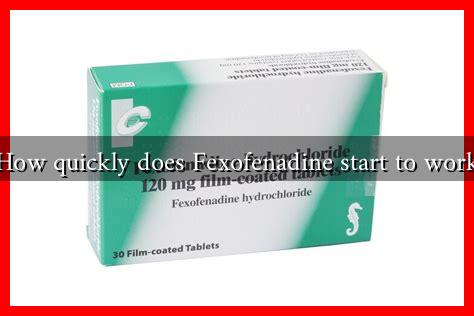-
Table of Contents
How Quickly Does Fexofenadine Start to Work?
Fexofenadine is a popular antihistamine used primarily to relieve allergy symptoms such as sneezing, runny nose, and itchy eyes. As with any medication, understanding how quickly it begins to work can significantly impact its effectiveness for those suffering from allergies. This article delves into the pharmacokinetics of fexofenadine, its onset of action, and factors that may influence its effectiveness.
Understanding Fexofenadine
Fexofenadine is a second-generation antihistamine that is less likely to cause drowsiness compared to first-generation antihistamines like diphenhydramine. It works by blocking the action of histamine, a substance in the body that causes allergic symptoms. Fexofenadine is commonly prescribed for:
- Seasonal allergic rhinitis (hay fever)
- Chronic idiopathic urticaria (hives)
It is available in various forms, including tablets, orally disintegrating tablets, and suspension, making it accessible for different patient needs.
Onset of Action: How Quickly Does It Work?
One of the most frequently asked questions about fexofenadine is how quickly it starts to work. Clinical studies have shown that fexofenadine typically begins to take effect within:
- 1 hour after oral administration
- Peak effects are usually observed around 2 to 3 hours post-dose
For many users, relief from allergy symptoms can be felt relatively quickly, making it a preferred choice for those needing immediate relief. However, the onset of action can vary based on several factors.
Factors Influencing Onset of Action
While fexofenadine generally works quickly, several factors can influence how soon a person may feel its effects:
- Dosage: Higher doses may lead to a quicker onset of action, but it is essential to follow prescribed dosages to avoid potential side effects.
- Food Intake: Taking fexofenadine with a high-fat meal can delay its absorption, potentially prolonging the time it takes to feel relief.
- Individual Metabolism: Each person’s metabolic rate can affect how quickly the drug is processed in the body. Factors such as age, weight, and overall health can play a role.
- Formulation: Different formulations (e.g., orally disintegrating tablets vs. standard tablets) may have varying absorption rates.
Case Studies and User Experiences
Numerous case studies and anecdotal evidence support the rapid onset of fexofenadine. For instance, a study published in the Journal of Allergy and Clinical Immunology found that patients reported significant relief from symptoms within one hour of taking the medication. Many users have shared their experiences on forums, noting that they often feel a marked improvement in their symptoms shortly after ingestion.
Comparative Analysis with Other Antihistamines
When comparing fexofenadine to other antihistamines, it is essential to consider the onset of action:
- Loratadine: Typically takes about 1 to 3 hours to start working.
- Cetirizine: Generally begins to work within 1 hour, with peak effects at around 1 to 2 hours.
Fexofenadine’s rapid onset makes it a competitive option for those seeking quick relief from allergy symptoms.
Conclusion
Fexofenadine is an effective antihistamine that typically starts to work within one hour of ingestion, with peak effects occurring around two to three hours later. Factors such as dosage, food intake, individual metabolism, and formulation can influence its onset of action. For those suffering from allergies, understanding how quickly fexofenadine works can help in managing symptoms effectively. Always consult with a healthcare provider for personalized advice and to ensure the best treatment plan for your needs.




